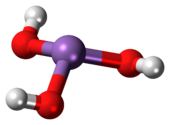Arsenous acid
 |
|
 |
|
| Names | |
|---|---|
|
IUPAC name
Arsorous acid
|
|
| Other names
Arsenious acid
Arsenic oxide |
|
| Identifiers | |
|
13464-58-9 |
|
| 3D model (Jmol) | Interactive image |
| ChEBI |
CHEBI:49900 |
| ChemSpider |
530 |
| DrugBank |
DB04456 |
| PubChem | 545 |
|
|
|
|
| Properties | |
| H3AsO3 | |
| Molar mass | 125.94 g/mol |
| Appearance | Only exists in aqueous solutions |
| -51.2·10−6 cm3/mol | |
| Hazards | |
| Main hazards | Toxic, corrosive |
| US health exposure limits (NIOSH): | |
|
PEL (Permissible)
|
[1910.1018] TWA 0.010 mg/m3 |
|
REL (Recommended)
|
Ca C 0.002 mg/m3 [15-minute] |
|
IDLH (Immediate danger)
|
Ca [5 mg/m3 (as As)] |
| Related compounds | |
|
Related compounds
|
Arsenic acid |
|
Except where otherwise noted, data are given for materials in their standard state (at 25 °C [77 °F], 100 kPa).
|
|
|
|
|
| Infobox references | |
Arsenous acid (or arsenious acid) is the inorganic compound with the formula H3AsO3. It is known to occur in aqueous solutions, but it has not been isolated as a pure material, although this fact does not detract from the significance of As(OH)3.
As(OH)3 is a pyramidal molecule consisting of three hydroxyl groups bonded to arsenic. The 1H NMR spectrum of arsenous acid solutions consists of a single signal consistent with the molecule's high symmetry. In contrast, the nominally related phosphorus species H3PO3 mainly adopts the structure HPO(OH)2; P(OH)3 is a very minor equilibrium component of such solutions. The differing behaviors of the As and P compounds reflect a trend whereby high oxidation states are more stable for lighter members of main group elements than their heavier congeners.
The preparation of As(OH)3 involves a slow hydrolysis of arsenic trioxide in water. Addition of base converts arsenous acid to the arsenite ions [AsO(OH)2]−, [AsO2(OH)]2−, and [AsO3]3−. The first pKa is 9.2, As(OH)3 is a weak acid. Reactions attributed to aqueous arsenic trioxide are due to arsenous acid and its conjugate bases.
Arsenic-containing compounds are highly toxic and carcinogenic. The anhydride form of arsenous acid, arsenic trioxide, is used as a herbicide, pesticide, and rodenticide.
...
Wikipedia
